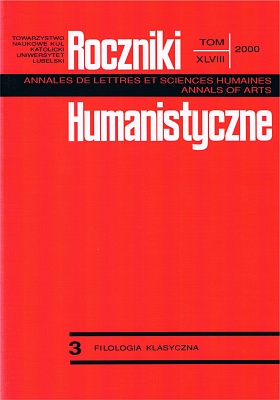Plutarcha Vita Solonis 8, 4-6 i Tesmoforia attyckie
Abstrakt
The article is devoted to the problem of the connection between the feast of women gathered in the Demeter Thesmophoria shrine on Cape Kolias (deme Halimous) and the celebrations of Thesmophoria in Athens. The starting point for the author is Plutarch's story (Vita Solonis 8, 4-6) that today is considered to be the proof of the tenth day of the month Pyanopsion rites which were part of the Athenian Thesmophoria. On that day women were supposed to go to the seaside sanctuary and then to move to the Demeter temenos in the center of Athens. The local feast was to be included in the state celebrations, but the problematic verse 80 of Aristophanes' Women at Thesmaphoria was thought to be a trace of its original separateness.
A careful analysis of Plutarch and the tradition on which he is dependent (Polyainos) shows that the feast on Cape Kolias is not the same as the Thesmophoria. Numerous researchers compare Plutarch's accounts with the tradition of seizing the Megarians who conducted a plundering raid whose purpose was to abduct the women who had gathered at Thesmaphoria (Aeneas Tacticus, 4.8-12). Most of them think that it is the same tradition that was later divided in two. Differences between the accounts show that these are separate traditions dealing with different events. The stories are about different leaders (Solon in Halimous, Pisistratus in Eleusis). The course of the rites and their role in the related account differ from the ritual scenario in the shrine on Cape Kolias. In Eleusis the women probably remained in the sacred circle during the rites, and anyway they did not take part in the events. Hence there is no motif of young men putting on women's clothes with hidden daggers and of the dance on the sea-shore that is strongly emphasized in the tradition concerning Solon's ruse (apate) in Halimous. A lot points to the initiation scenario being at the root of Plutarch and Polyainos' story. A change in the status is also seen in the ritual behavior: choirs in the Demeter feast consist of boys; and the feast is the domain of women only. By temporarily entering the women's world the participants in the rite-event are transformed into warriors. The fight they will have to wage is different from hoplites' fight as victory depends on a ruse. Hence the initiation rite is a distant background for the story of the war against Megara. The rite seems to be different from the feast of Thesmophoria and to remind of rites from other Greek territories (Amnissos on Crete) that are similar in their structure.
The fact that Plutarch's story about the celebrations of Thesmophoria is different does not mean that the thesmophoria in Halimous did not take place. Beside the main thought of the article the author has made an analysis of the evidence concerning the Thesmophoria on the territories of Attica, which has fully confirmed Kevin Clinton's thesis about a local character of the feast. Source evidence does not allow including the deme Halimous as the first day of the celebrations in Athens. They remained a separate feast, but contrary to other local celebrations they began on the tenth day of the month Pyanopsion.
Bibliografia
BakalakisG.: Les „kernoi” éleusiniens. „Kernos” 4:1991 s. 105-117.
Bremmer J.: Greek Religion. Greece and Rome. New Surveys in the Classics 24. Oxford 1994.
Broneer O.: The Thesmophorion in Athens. „Hesperia” 11:1940 s. 299-320.
Brumfield A.: The Attic Festivals of Demeter and their Relation to the Agricultural Year. Salem-New Hampshire: The Ayer Company 1981.
Clinton K.: The Thesmophorion in Central Athens and the Celebration of the Thesmophoria in Attica. W: The Role of Religion in the Early Greek Polis. Ed. R. Hägg. Stockholm 1996 s. 111-125.
Coulon V.: Aristophane. Vol. 4. Paris 1928.
Deubner L.: Attische Feste. Berlin 19662.
Faraguna M.: Atene nell'età di Alessandro. Roma 1992.
Hollis A. S.: Attica in Hellenistic Poetry. „Zeitschrift für Papyrologie und Epigrafik” 1994.
Lambert S. D.: The Phratries of Attica. Ann Arbor 1993.
Mikalson J.: Religion in the Attic Demes. „American Journal of Philology” 98:1987 s. 424-435.
Nilsson M.: Griechische Feste von Religioser Bedeutung. Leipzig 1906.
Parke H. W.: Festivals of the Athenians. London 1977.
Robertson N.: New Light on Demeter's Mysteries. „Greek, Roman and Byzantine Studies” 37:1996 s. 319-379.
Sommerstein A. H.: Aristophanes. Thesmophoriazusae. Warmister 1994.
Sourvinou-Inwood Ch.: What is „Polis” Religion? W: The Greek City. From Homer to Alexander. Ed. O. Murray, S. Price. Oxford 1990 s. 295-322.
Zwolski E.: Choreia. Warszawa 1978.
Copyright (c) 2000 Roczniki Humanistyczne

Utwór dostępny jest na licencji Creative Commons Uznanie autorstwa – Użycie niekomercyjne – Bez utworów zależnych 4.0 Międzynarodowe.





